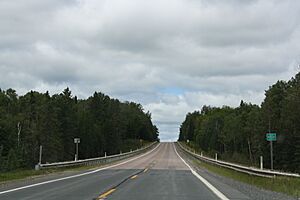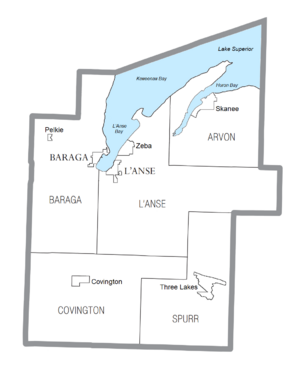Baraga County, Michigan facts for kids
Quick facts for kids
Baraga County
|
|||
|---|---|---|---|
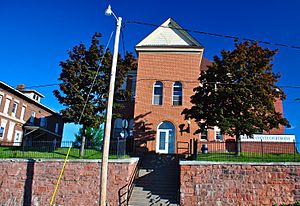
Baraga County Courthouse and Annex (July 2014)
|
|||
|
|||
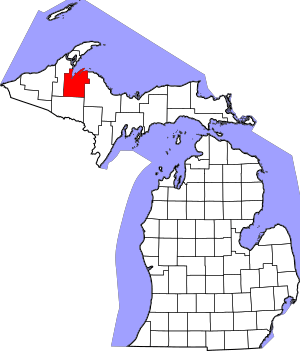
Location within the U.S. state of Michigan
|
|||
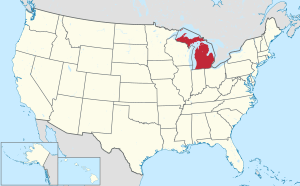 Michigan's location within the U.S. |
|||
| Country | |||
| State | |||
| Founded | February 19, 1875 | ||
| Named for | Frederic Baraga | ||
| Seat | L'Anse | ||
| Largest village | Baraga | ||
| Area | |||
| • Total | 1,069 sq mi (2,770 km2) | ||
| • Land | 898 sq mi (2,330 km2) | ||
| • Water | 171 sq mi (440 km2) 16%% | ||
| Population
(2020)
|
|||
| • Total | 8,158 | ||
| • Density | 9.9/sq mi (3.8/km2) | ||
| Time zone | UTC−5 (Eastern) | ||
| • Summer (DST) | UTC−4 (EDT) | ||
| Congressional district | 1st | ||
Baraga County (pronounced BAIR-ə-gə) is a county in the Upper Peninsula of Michigan. It is located in the U.S. state of Michigan. In 2020, about 8,158 people lived there. This makes it one of Michigan's least populated counties.
The main town, or county seat, is L'Anse. The county is named after Bishop Frederic Baraga. He was a Catholic missionary. He worked with the Ojibwa Native American people in the Michigan Territory. The L'Anse Indian Reservation is also found within Baraga County.
Contents
Exploring Baraga County
Baraga County covers a total area of about 1,069 square miles. Most of this area, 898 square miles, is land. The rest, 171 square miles, is water. This means about 16% of the county is covered by water.
The county is in Michigan's Upper Peninsula. It sits right on the shore of Lake Superior. It is also at the bottom of the Keweenaw Peninsula. The villages of Baraga and L'Anse are located here. They are at the base of Lake Superior's Keweenaw Bay. A piece of land called Point Abbaye sticks out into the lake. It helps form Huron Bay.
The eastern part of Baraga County has many Huron Mountains. This includes Mount Arvon. Mount Arvon is the highest natural point in Michigan. It stands tall at 1,979 feet (603 meters).
Main Roads in Baraga County
Several important roads run through Baraga County. These roads help people travel and connect communities.
 US 41: This highway goes north and south. It runs along the shore of Keweenaw Bay. It passes through Baraga and L'Anse.
US 41: This highway goes north and south. It runs along the shore of Keweenaw Bay. It passes through Baraga and L'Anse. US 141: This road goes south from US-41. It leads into Iron County.
US 141: This road goes south from US-41. It leads into Iron County. M-28: This highway enters from the west. It goes east towards US-141.
M-28: This highway enters from the west. It goes east towards US-141. M-38: This road runs east and west. It connects to US-41 in Baraga.
M-38: This road runs east and west. It connects to US-41 in Baraga.
Neighboring Counties
Baraga County shares its borders with a few other counties:
- Marquette County to the east
- Iron County to the south
- Houghton County to the west
Protected Natural Areas
Parts of two national protected areas are found in Baraga County:
Communities in Baraga County
Baraga County has several towns and communities.
Villages
Townships
These are smaller government areas within the county:
Census-Designated Places
These are areas that the U.S. Census Bureau defines for gathering population data:
Other Small Communities
Many other small, unincorporated communities exist in Baraga County:
Indian Reservations
The L'Anse Indian Reservation is a significant area in Baraga County. It includes parts of Baraga, L'Anse, and Arvon townships. A very small part of the reservation is also in Marquette County.
People of Baraga County
| Historical population | |||
|---|---|---|---|
| Census | Pop. | %± | |
| 1880 | 1,804 | — | |
| 1890 | 3,036 | 68.3% | |
| 1900 | 4,320 | 42.3% | |
| 1910 | 6,127 | 41.8% | |
| 1920 | 7,662 | 25.1% | |
| 1930 | 9,168 | 19.7% | |
| 1940 | 9,356 | 2.1% | |
| 1950 | 8,037 | −14.1% | |
| 1960 | 7,151 | −11.0% | |
| 1970 | 7,789 | 8.9% | |
| 1980 | 8,484 | 8.9% | |
| 1990 | 7,954 | −6.2% | |
| 2000 | 8,746 | 10.0% | |
| 2010 | 8,860 | 1.3% | |
| 2020 | 8,158 | −7.9% | |
| 2023 (est.) | 8,310 | −6.2% | |
| US Decennial Census 1790–1960 1900–1990 1990–2000 2010–2018 |
|||
In 2010, Baraga County had a population of 8,860 people. This was a small increase from the year 2000. The population density was about 10 people per square mile.
The people living in Baraga County come from many different backgrounds. In 2010, most residents were White. A significant number were Native American. There were also people who identified as Black, Asian, or of two or more races. Some residents were also of Hispanic or Latino heritage. Many people in the county have Finnish, German, French, or Irish roots.
The median age in the county was about 42.9 years old in 2010. This means half the population was older than 42.9 and half was younger. About 20% of the population was under 18 years old.
See also
 In Spanish: Condado de Baraga para niños
In Spanish: Condado de Baraga para niños




